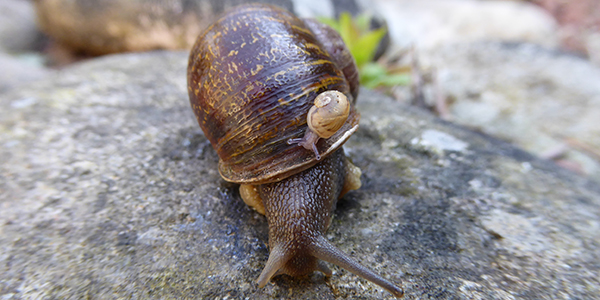
November 29, 2017, by Emma Thorne
Giving a snail a personality – all in the name of science
They’re a bit slimy and will happily munch their way through your home-grown lettuce and prize hostas. To many, the brown garden snail is more pest than national treasure, its common fate to be crunched under foot or unceremoniously lobbed into a neighbour’s garden.
But geneticist Dr Angus Davison in the School of Life Sciences is on a mission to educate people about why there may be more to these humble gastropods than initially meets the eye.
Tonight, he will face the public in an effort to persuade them to vote for one very special member of the Cornu aspersum family to take part in an iconic initiative to sequence the genome of 25 species to mark the 25th anniversary of the Sanger Institute.
A one in a million snail
Through a live chat via the I’m a Scientist website, Angus will champion Tomeu the snail for inclusion in Sanger’s 25 Genomes project. Tomeu faces tough competition, battling for a place against perennial favourites like the barn owl and the dragon fly.
But he reckons that a unique characteristic, which may offer us clues about our own development, could just give Tomeu the edge.
While in the UK brown garden snails number in the tens of millions, Tomeu and a rare number like him are one in a million snails whose shells coil in an anti-clockwise direction, rather than in the clockwise direction seen in more common snails.
While you’d have to go back a long way to find the most common ancestor with Homo sapiens, Angus’ research has shown that the same genes may be involved in defining the left and right sides of vertebrate and snail bodies. And these mutant, sinistral snails may be able to help us to understand why things sometimes go wrong, leading to human conditions such as situs inversus, in which internal organs are reversed or mirrored from their normal positions.
Angus is no stranger to coming up with innovative approaches to public engagement to educate people about genetics and, in particular, this fascinating group of rare snails.
Just over a year ago, he contacted the university Press Office seeking assistance in finding a mate for the original ‘lefty’ snail, Jeremy, in the hope that any resulting offspring could offer insights into whether their left-coiling trait is inherited or a quirk of development.
“Not even celebrity snails live forever” Science magazine, October 2017
After a successful pitch to BBC science journalist Tom Fielden led to Jeremy’s story being shared on Radio 4’s Today Programme and a #snaillove hashtage on Twitter, the snail’s story hit the headlines around the world.
For a year, a growing legion of ‘lefty snail’ fans followed his progress through the media, which included finding mates, Lefty from Ipswich and the Spanish ‘naturalised Brit’ Tomeu; being on the outside of a love triangle; and finally becoming a ‘father’ before his death in October this year.
The resulting media attention has led to the snail’s story – and Angus’ research – being exposed to a staggering potential audience of 1.9 billion people around the globe.
Angus said: “It is amazing to think that a fairly straightforward idea that I had one afternoon, while wondering what to do with a rare ‘lefty’ snail, could have such a massive worldwide impact – and also to help me communicate my science.
“Earlier in 2016, we reported that we had identified a gene that determines pond snail shell coiling direction and that this same gene may have a similar function in setting up the left and right sides of vertebrate bodies, including ourselves. While the scientifically inclined press took up this story, the report did not reach the wider public. That all changed when we found a rare ‘lefty’ garden snail, “Jeremy”, named after a well-known politician who also likes gardening.
“You might question whether we should be giving a lab animal a name. Well, the value was that although the underlying science was the same as that reported in our paper, “Jeremy” created an easy hook for journalists. Almost without exception, the press were very good to highlight the deeper story, that body asymmetry may be conserved between snails and humans – we still got our message across, many times.”
Log on to the 25 Genomes I’m a Scientist website to take part in the live web chat with Angus and Tomeu tonight from 8pm and to vote for Nottingham’s lefty snail to be part of the genome sequencing initiative.
No comments yet, fill out a comment to be the first

Leave a Reply